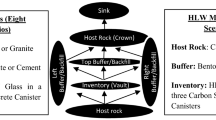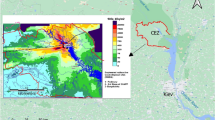Abstract
A regional strategy for safety disposal of low- and intermediate-level radioactive wastes (LILW) has been implemented in China to protect humans and the environment. A joint onsite and laboratory investigation was conducted for a field site in southern China to assess the probability for safe disposal of LILW, which requires the understanding of long-term radionuclide transport behaviors under field conditions. This study presents the field-scale modeling of radionuclide transport through weathered granites for a conservative, a weakly sorbing and a strongly sorbing tracer by incorporating laboratory and field data. The field-scale radionuclide transport model was developed on the basis of a validated long-term groundwater flow model and field-measured dispersion coefficient, as well as laboratory-characterized strontium and cesium distribution coefficients in the weathered granites. The model was then used to perform the long-term transport prediction and risk assessment of radionuclide pollution for both the natural site setting and the graded site setting. Model simulation reveals that the numerical sensitivities of calculated concentrations are tracer dependent and changing with time. The conservative radionuclide is most sensitive to changes in hydraulic conductivity (K) while slightly sensitive to changes in effective porosity (φ), specific yield (μ) and longitudinal dispersion coefficient (D L), indicating advection is the main transport process of conservative radionuclide. The weakly and strongly sorbing tracers, on the other hand, are most sensitive to changes in the distribution coefficient (K d) and less sensitive to changes in the rest of model parameters, revealing that sorption is the main process for controlling the transport of sorbing tracers. A conservative radionuclide plume moves at an average velocity of about 54 m/a, which is too fast to be considered as safe disposal under the natural site setting. However, the plume of the conservative radionuclide could be slowed down to a velocity around 5.3 m/a due to the reduction of the hydraulic gradient under the graded site setting. Therefore, the conservative radioactive wastes could be disposed at the mid-eastern part of the site under the graded site setting because the transport path has been prolonged and thus no conservative radionuclides could migrate out of the site in a reasonable timeframe. For the sorbing tracers, however, results of the computed transport distance are 40 and 2 m at 500 years, respectively. Therefore, they can be disposed safely at the site under both natural and graded site settings. This study provides an insight to the field-scale long-term behaviors of radionuclide transport. The integrated modeling method presented in this study is most useful for the environmental impact assessment of the site conditions relevant to the safe disposal of hazardous wastes.








Similar content being viewed by others
References
Samper J Yang C Naves A et al (2006) A fully 3-D anisotropic numerical model of the DI-B in situ diffusion experiment in the Opalinus clay formation. Phys Chem Earth Parts A/B/C 31:531–540
Appelo CAJ, Wersin P (2007) Multicomponent diffusion modeling in clay systems with application to the diffusion of tritium, iodide, and sodium in opalinus clay. Environ Sci Technol 41:5002–5007
Bear J (1972) Dynamics of fluids in porous media. Elsevier, New York 764 pp
China Institute of Atomic Energy (2010) Tests of radionuclides transport in the soils of Shaoguan site for disposal of Low- and intermediate-level radioactive wastes. Technical reports, Wuhan Nov 2010, 19 p
El-Ghonemy H, Watts L, Fowler L (2005) Treatment of uncertainty and developing conceptual models for environmental risk assessments and radioactive waste disposal safety cases. Environ Int 31:89–97
García-Gutiérrez M, Cormenzana JL, Missana T et al (2006) Large-scale laboratory diffusion experiments in clay rock. Phys Chem Earth 31:523–530
Jakob A, Pfingsten W, Van Loon L (2009) Effects of sorption competition on caesium diffusion through compacted argillaceous rock. Geochim Cosmochim Acta 73:2441–2456
Lee C, Lee C, Yeh H, Lin H (2011) Modeling spatial fracture intensity as a control on flow in fractured rock. Environ Earth Sci 63(6):1199–1211
Li X, Zhang J (2010) Report on the geotechnical engineering investigation for disposal of low and intermediate level radioactive waste in the Yaotian site: feasibility study stage. Guangdong Electric Power Design Institute. Sep., 2010, 95 p
Li X, Li Z, Li C et al (2009) Report of the preliminary feasibility study on the disposal of low and intermediate level solid radioactive waste in Shaoguan. CGN, Nov. 2009, 255 p
Liu CW, Narasimhan TN (1989) Redox-controlled multiplespecies reactive chemical transport, 2, verification and application. Water Resour Res 25:883–910
Liu C, Zachara JM, Qafoku NP, Wang Z (2008) Scale-dependent desorption of uranium from contaminated subsurface sediments. Water Resour Res 44:W08413. doi:10.1029/2007WR006478
Ma R, Zheng C, Prommer H et al (2010) A field-scale reactive transport model for U(VI) migration influenced by coupled multirate mass transfer and surface complexation reactions. Water Resour Res 46:W05509. doi:10.1029/2009WR008168
Palut JM, Montarnal P, Gautschi A et al (2003) Characterisation of HTO diffusion properties by in-situ tracer experiment in Opalinus clay at Mont Terri. J Contam Hydrol 61:203–218
Prommer H, Barry DA, Zheng C (2003) MODFLOW/MT3DMS-based reactive multicomponent transport modeling. Ground Water 41(2):247–257
Reardon EJ (1981) Kd’s—can they be used to describe reversible ion sorption reaction in contaminant migration? Ground Water 19(3):279–286
Samper J, Yi S, Naves A (2010) Analysis of parameter identifiability of the in situ diffusion and retention (DR) experiments. Phys Chem Earth 35:207–216
Shang J, Liu C, Wang Z, Zachara JM (2011) Effect of grain size on uranium (VI) surface complexation kinetics and adsorption additivity. Environ Sci Technol 45:6025–6031
Tison JL (2009) 40 years of operation of near surface repositories. Andra Experience. CEG WORKSHOP. Feb. 2009, Bommersvik, 36 p
Van der Lee J, Windt LD (2001) Present state and future directions of modelling of geochemistry in hydrogeological systems. J Contam Hydrol 47:265–282
Van Loon LR, Baeyens B, Bradbury MH (2009) The sorption behaviour of caesium on Opalinus Clay: a comparison between intact and crushed material. Appl Geochem. doi: 10.1016/j.apgeochem.2009.03.003
Wersin P, Van Loon LR et al (2004) Long-term diffusion experiment at Mont Terri: first results from field and laboratory data. Appl Clay Sci 26:123–135
Xu T, Pruess K, Brimhall G (1999) An improved equilibrium-kinetics speciation algorithm for redox reactions in variably saturated subsurface flow systems. Comput Geosci 25:655–666
Yeh GT, Tripathi VS (1991) A model for simulating transport of reactive multispecies components: model development and demonstration. Water Resour Res 27(12):3075–3094
Yi S, Ma H, Zheng C, Zhu X, Hua’an W, Li X, Hu X, Qin J (2012a) Assessment of condictions for disposal of low- and intermediate-level radioactive wastes: a case study in southern China. Sci Total Environ 414:624–631
Yi S, Javier S, Acacia N, Soler JM (2012b) Identifiabiligy of diffusion and retention parameters of anionic tracers from the DR experiment. J Hydrol 446–447:70–76
Zheng C, Wang P (1999) PMT3DMS:a modular three-dimensional multi-species model for simulation of advection. Dispersion and chemical reactions of contaminants in groundwater systems: documentation and user’s guide, SERDP-99-1, US Army Engineer Research and Development Center, Vicksburg, MS
Acknowledgments
This work was supported by the National Natural Science Foundation of China through project 41202163 and the Guangdong Natural Science Foundation through project S2011040005245.
Author information
Authors and Affiliations
Corresponding author
Rights and permissions
About this article
Cite this article
Yi, S., Ma, H., Zheng, C. et al. A field-scale long-term study on radionuclide transport through weathered granites at a site in southern China. Environ Earth Sci 72, 4427–4439 (2014). https://doi.org/10.1007/s12665-014-3343-1
Received:
Accepted:
Published:
Issue Date:
DOI: https://doi.org/10.1007/s12665-014-3343-1




